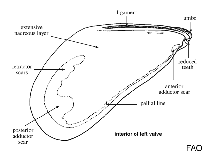Modiolus rectus (Conrad, 1837)
Straight horsemussel| Native range | All suitable habitat | Point map | Year 2050 |

|
| This map was computer-generated and has not yet been reviewed. |
| Modiolus rectus AquaMaps Data sources: GBIF OBIS |
Hochladen Photos
Google Bild | No image available for this species;
drawing shows typical species in Mytilidae.
Google Bild | No image available for this species;
drawing shows typical species in Mytilidae.
Classification / Names Common names | Synonyms | CoL | ITIS | WoRMS
Bivalvia | Mytilida | Mytilidae
Environment: milieu / climate zone / depth range / distribution range Ökologie
; tiefenbereich 0 - 15 m (Ref. 95344). Subtropical
Verbreitung Länder | FAO Gebiete | Ecosystems | Vorkommen | Einführungen
Northern and Central Pacific and Northeast Atlantic: UK.
Length at first maturity / Size / Gewicht / Alter
Maturity: Lm ? range ? - ? cm Max length : 23.0 cm TL Männchen/unbestimmt; (Ref. 95344)
Life cycle and mating behavior Geschlechtsreife | Fortpflanzung | Ablaichen | Eier | Fecundity | Larven
Members of the class Bivalvia are mostly gonochoric, some are protandric hermaphrodites. Life cycle: Embryos develop into free-swimming trocophore larvae, succeeded by the bivalve veliger, resembling a miniature clam.
Hauptreferenz
Referenzen | Koordinator | Partner
Turgeon, D.D., J.F. Quinn Jr., A.E. Bogan, E.V. Coan, F.G. Hochberg, W.G. Lyons, P.M. Mikkelsen, R.J. Neves, C.F.E. Roper, G. Rosenberg, B. Roth, A. Scheltema, F.G. Thompson, M. Vecchione and J.D. Willams. 1998. (Ref. 1667)
IUCN Rote Liste Status (Ref. 130435: Version 2024-1)
CITES Status (Ref. 108899)
Not Evaluated
CMS (Ref. 116361)
Not Evaluated
Bedrohung für Menschen
Nutzung durch Menschen
| FishSource |
Tools
Mehr Information
Trophic Ecology
Ecology
Population dynamics
Wachstum
Alter/Größe
Länge-Gewicht
Länge-Länge
Längenhäufigkeiten
Mass conversion
Rekrutierung
Dichte
Alter/Größe
Länge-Gewicht
Länge-Länge
Längenhäufigkeiten
Mass conversion
Rekrutierung
Dichte
Life cycle
Distribution
Human Related
Aquakultur Profil
Stamps, Coins Misc.
Stamps, Coins Misc.
Outreach
References
Internet Quellen
BHL | BOLD Systems | CISTI | DiscoverLife | FAO(Publication : search) | Fishipedia | GenBank (Genom, nucleotide) | GloBI | Gomexsi | Google Books | Google Scholar | Google | PubMed | Tree of Life | Wikipedia (Gehe zu, Suchen) | Zoological Record
Estimates based on models
Preferred temperature
(Ref. 115969): 7.1 - 17.2, mean 10.2 (based on 519 cells).



